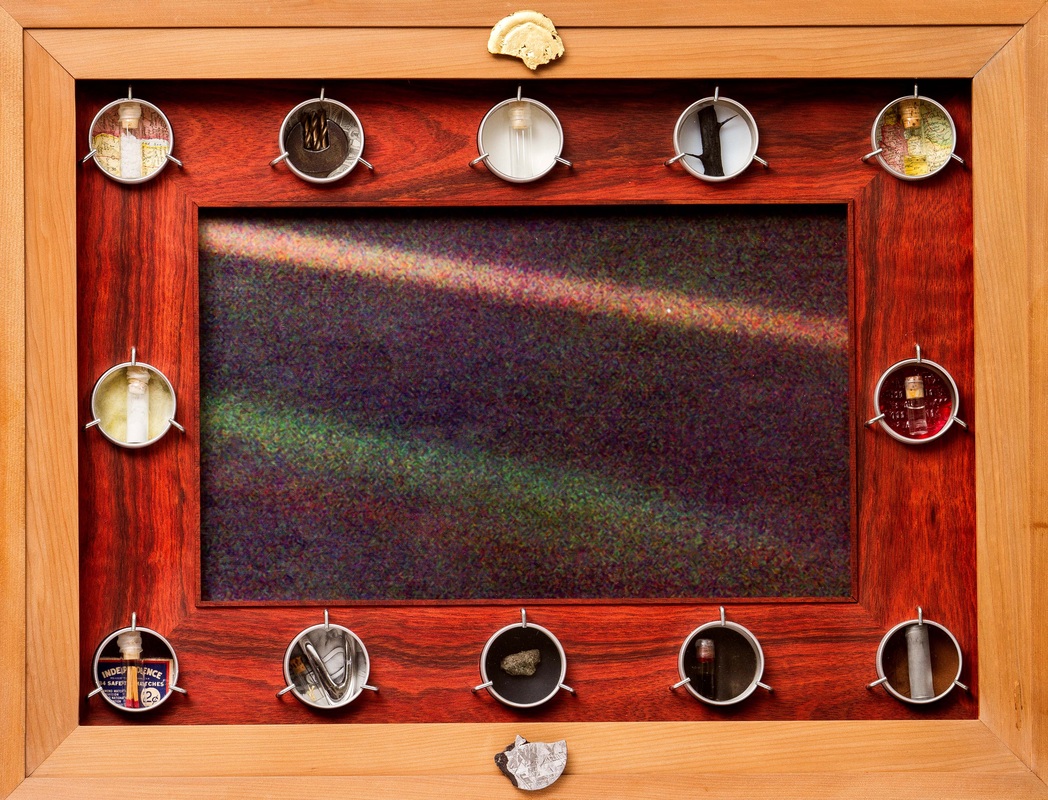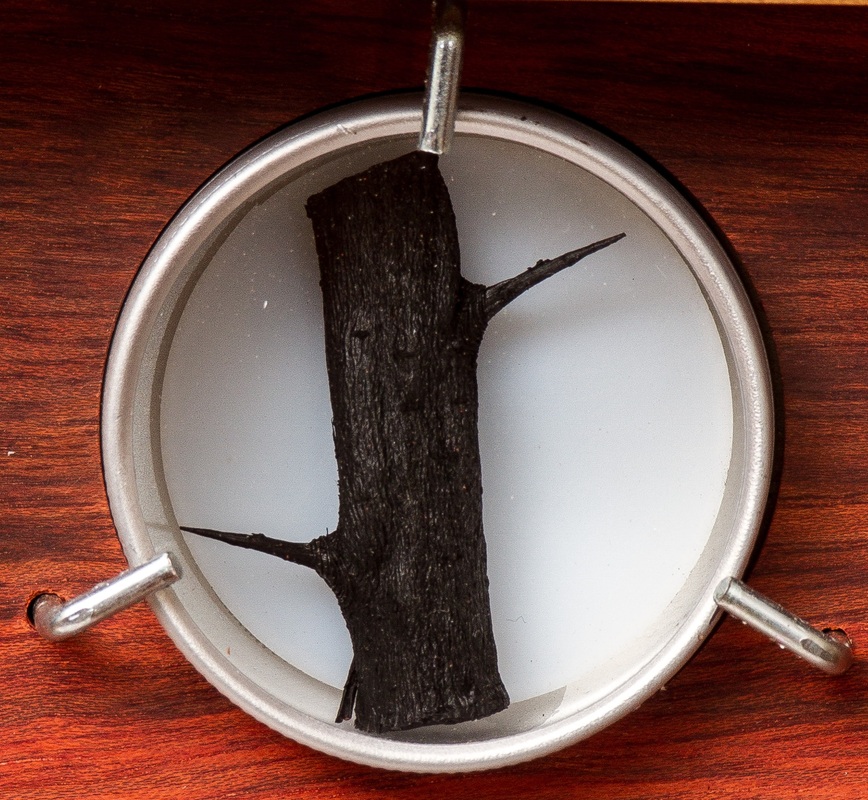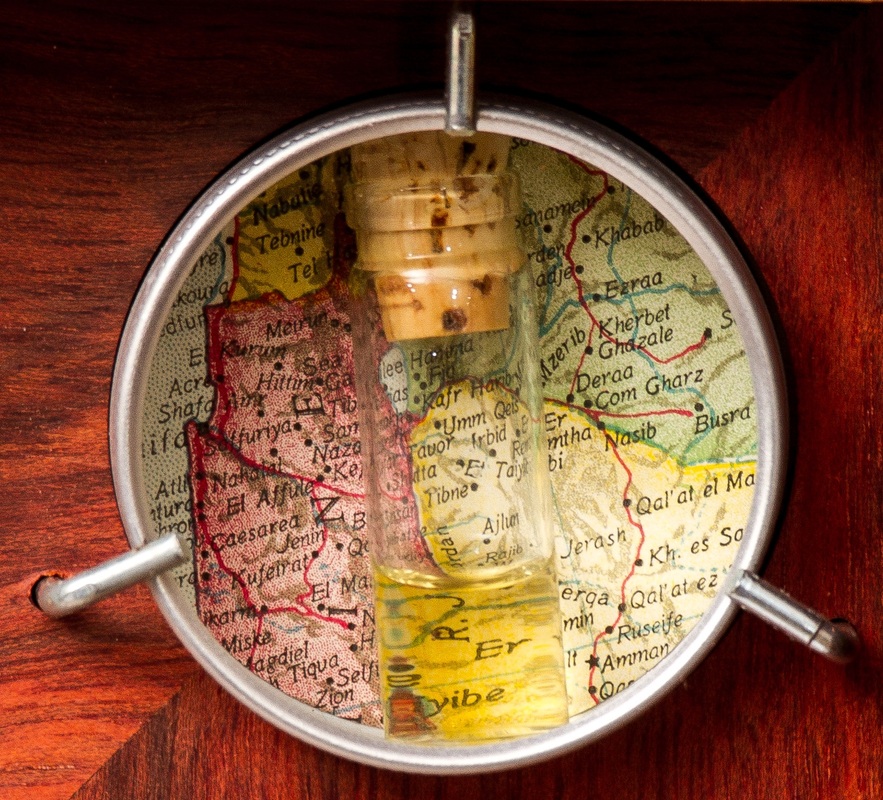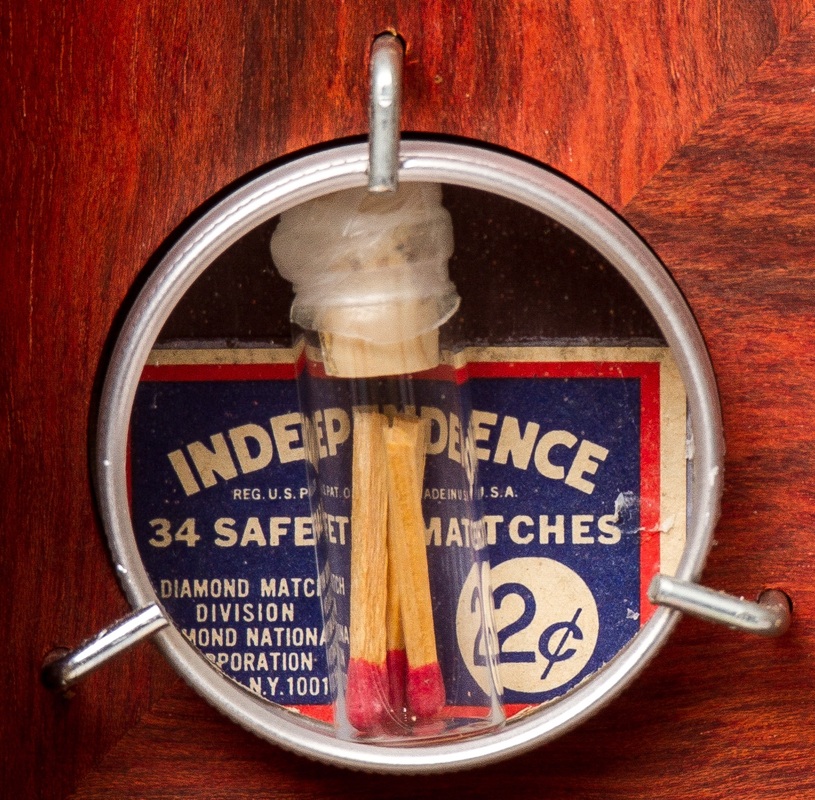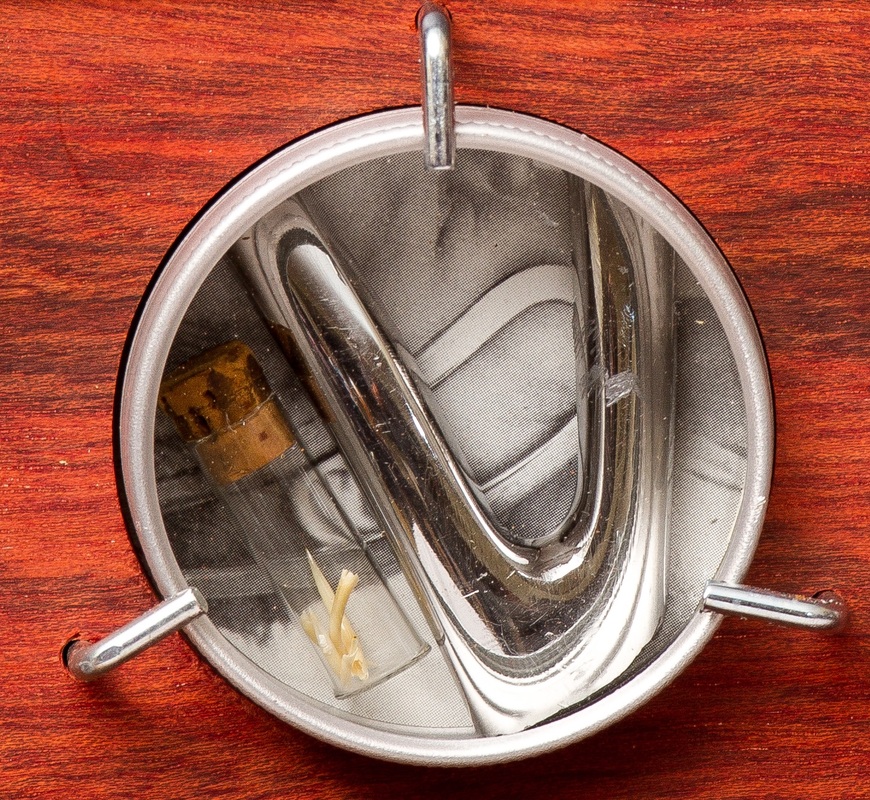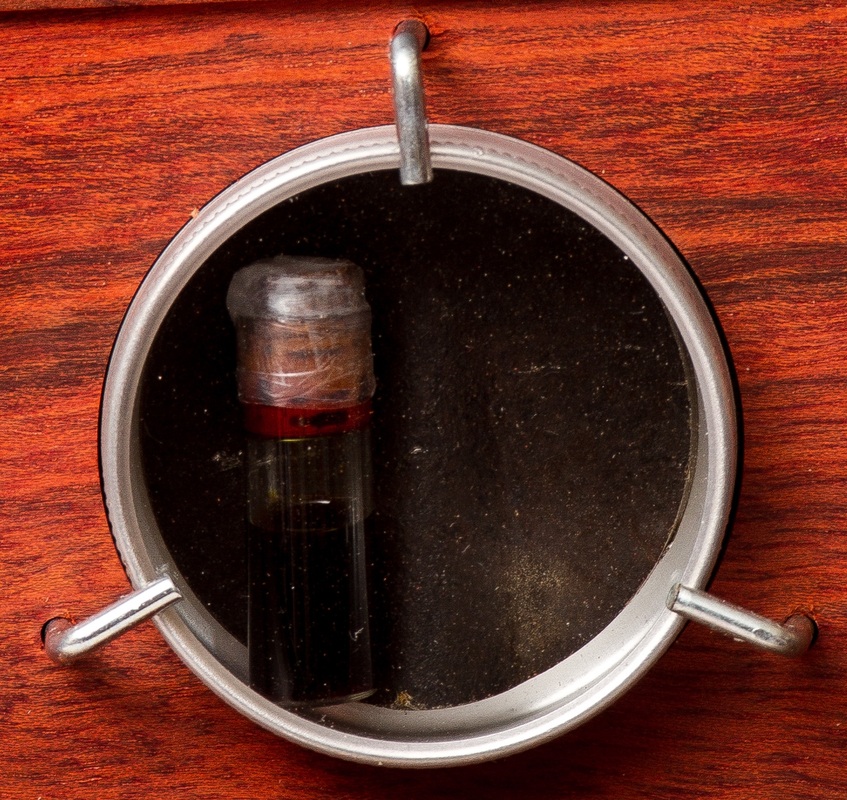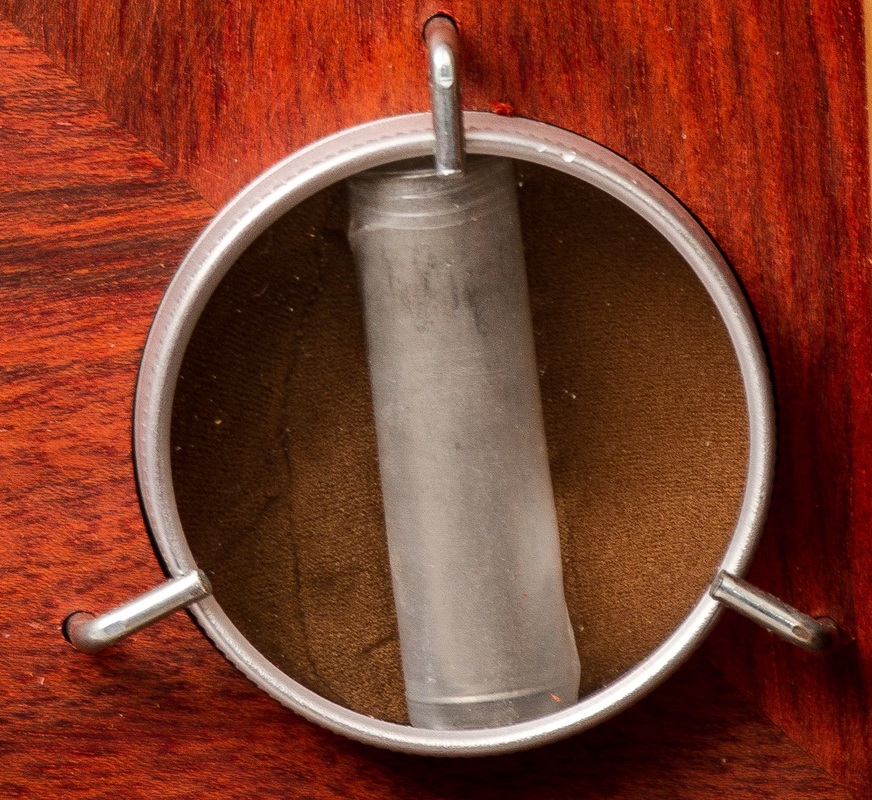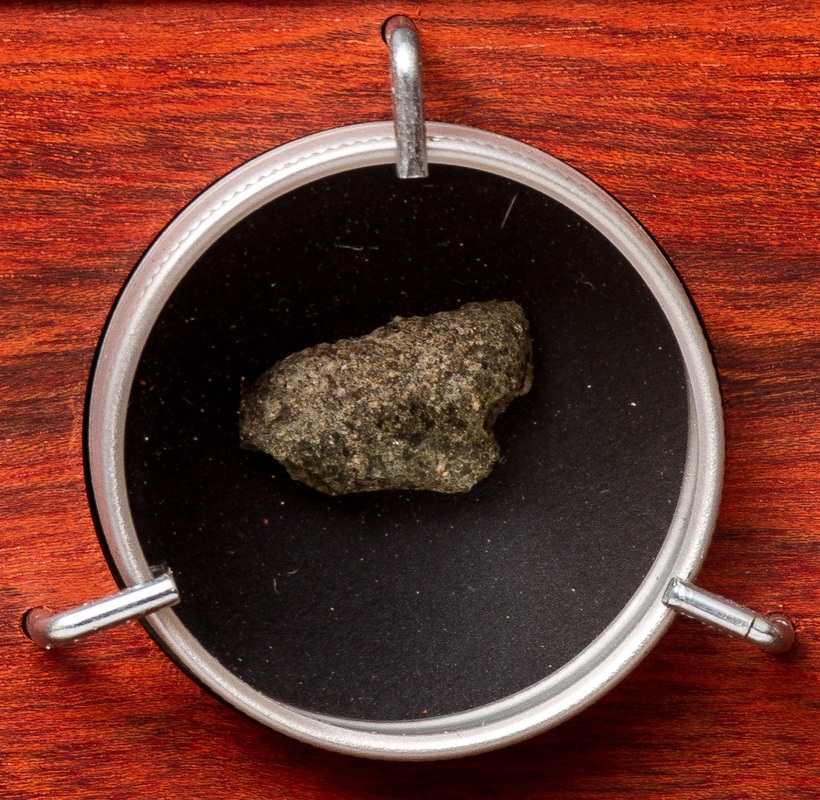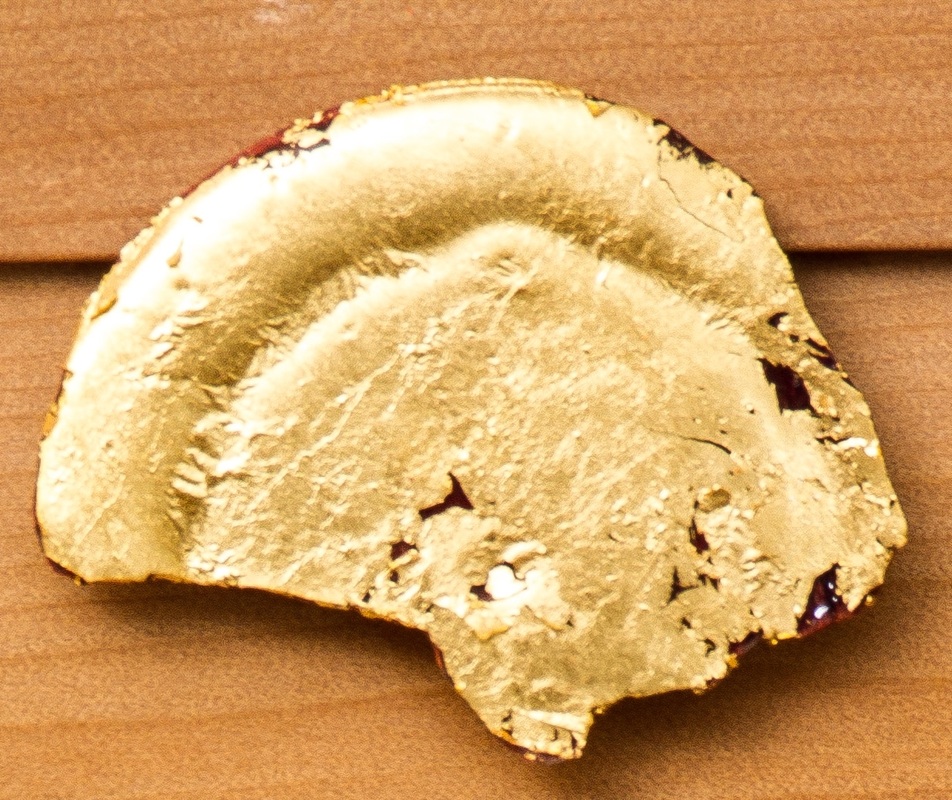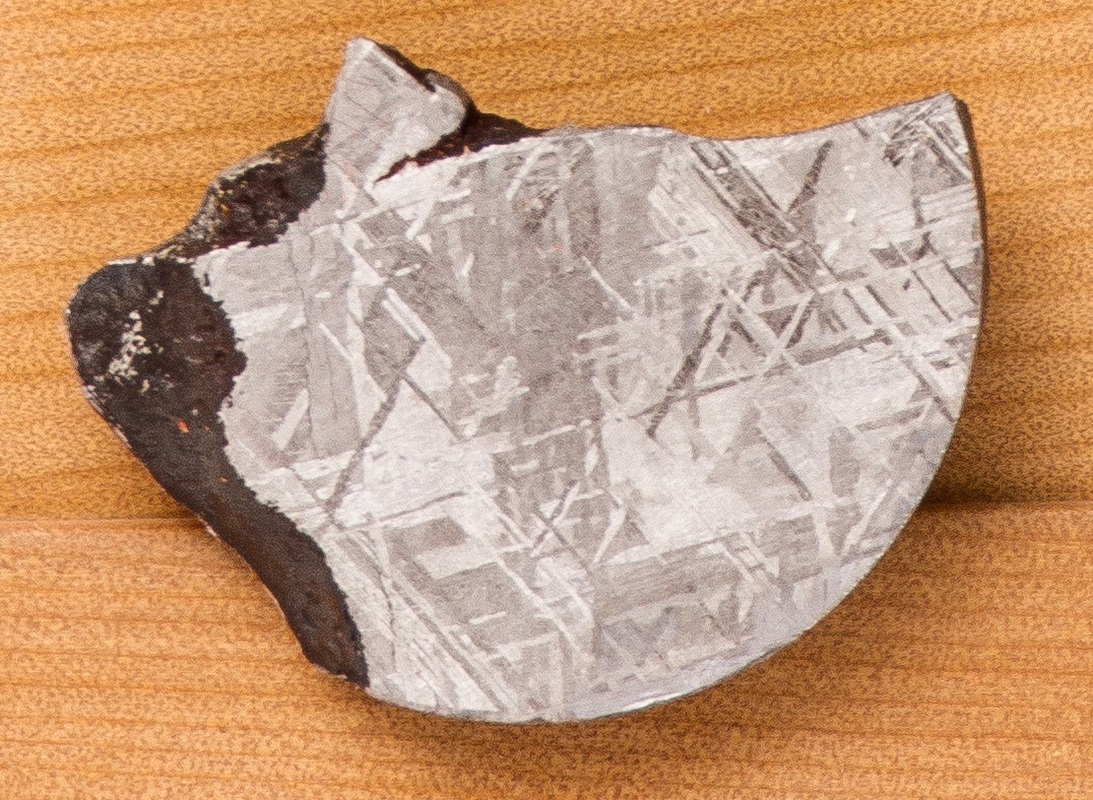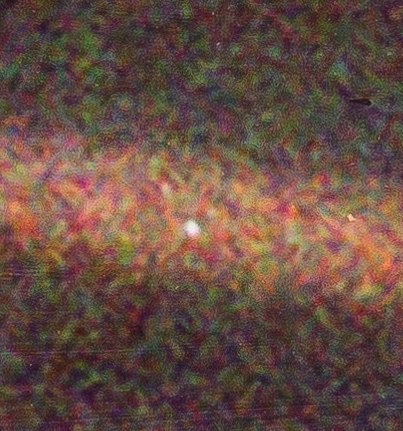Mote of Dust
Mote of Dust by John M. Robertson
Medium: alkaline battery, ancient kauri wood, artist’s exhaled breath, bloodwood, charcoal thorny stem, bleach, Dead sea salt, drill bits, fiberglass, garden hoe, Gibeon meteorite, gold gilding, maps, matchbox, obstetrical forceps, paper, photograph, quicklime, red traffic signal, safety matches, snake fangs, Teflon®, tincture of iodine, Trinitite, watchmaker canisters, water from the river Jordan, wrench.
Size: 19 1/8" x 26 7/8"x 2"
Date: 2013
Description:
The title comes from a book by Carl Sagan called Pale Blue Dot inspired by the photograph of the same name. This photograph (PIA00452) was taken in 1990 by the Voyager I spacecraft after it had passed beyond Pluto, 3.7 billion miles from earth. In the photo, the earth is the size of 0.12 pixels, literally “a mote of dust, suspended in a sunbeam.” When I first saw this, I was overwhelmed by how small the earth appeared in what was just a sliver of the vast universe captured by the photo. Psalm 8:4 from the Old Testament came to mind - “What is man, that thou art mindful of him?” This piece is a meditation upon this question.
The majority of this piece is taken up by the photograph. The photo is cropped so that the length and width are in the ratio of phi (1.618...), otherwise known as the Golden Ratio. This creates a Golden Rectangle out of the photograph. The earth pixel occupies the upper right portion of the photograph in a point nicknamed the “eye of God” because of the mathematical properties of the Golden Rectangle. This point is at the center of a specific logarithmic spiral called the Golden Spiral created by the golden rectangle. The spiral infinitely approaches but never reaches this point in space. Therefore, “eye of God” represents that which is at once both finite and infinite.
The frame is made from ancient kauri wood (agathis australis). This is wood from 1,200 year old trees felled by natural causes in ancient time and is the world’s oldest workable wood. It was preserved underground in the anaerobic environment of a prehistoric swamp, preventing decomposition.
The human body is composed of at least 26 chemical elements. These elements are nothing special in and of themselves. Ringed around the photograph are 12 watchmaker canisters that hold objects that are composed of these 26 elements. These objects represent some aspect of the human condition as described in “Creation of Man” or “The Fall of Man” from the Old Testament book of Genesis, chapters 2 and 3.
Canister #1 contains a vial of the artist’s exhaled breath and represents both oxygen and the “breath of life” (Genesis 2:7). The background is pure white watercolor paper.
Canister #2 contains a charcoal thorny stem with a background of Teflon®, representing the elements carbon and fluorine, respectively. The width of the thorny stem is the same size as the artist’s thumb in reference to the “rule of thumb” law in the 1700's in England allowing a husband to beat his wife provided he uses a stick no thicker than his thumb. This alludes to Genesis 3:16 where a husband would "rule over" his wife. The thorny stem also refers to "the ground will produce thistles and thorns for you" (Genesis 3:17). Teflon® provides a clean, non-stick surface but cannot protect mankind against the thorns.
Canister #3 contains a vial of water (hydrogen) from the river Jordan with a background of a map of the river. This was the river in which Jesus was baptized (Matthew 3:5-16).
Canister #4 contains sulfur safety matches and a matchbox with a striking surface containing phosphorous. The need for warmth after man’s expulsion from the Garden of Eden is alluded to in Genesis 3:21 when garments from animal skin were made by God for Adam and Eve.
Canister #5 contains a vial of quicklime* (containing calcium) on a background of fiberglass insulation (containing boron). Quicklime historically has been used in the prevention of disease from dead bodies, particularly in mass graves. Insulation again alludes to the need for warmth. *calcium oxide
Canister #6 contains snake fangs (also representing calcium) and obstetrical forceps made of surgical stainless steel (composition includes molybdenum, chromium, nickel). These objects represent Genesis 3:15-16 regarding the enmity created between the woman and the woman’s offspring to serpents as well as the increase in the pain of childbirth. Obstetrical forceps are only used in very difficult deliveries.
Canister #7 contains a vial of Dead Sea salt which contains the elements sodium, potassium and magnesium. This references the call of believers to be like salt (Matthew 5:13).
Canister #8 contains a vial of chlorine bleach** and a red traffic light lens (selenium). The traffic lens refers to “The Law”, the breaking of which constitutes sin, referred to repeatedly in the Old Testament as a stain or blemish (Isaiah 1:18). **sodium hypochlorite
Canister #9 contains a vial of a tincture of iodine and an iron garden hoe. This represents the Genesis 3:17 which states that man would obtain his food “by the sweat of your brow.” The iodine is an antiseptic. A substance to treat infection would not have been needed before the Fall, when death and thus disease entered the world.
Canister #10 contains an alkaline battery (copper, zinc) atop a paper disc covered in nylon (nitrogen), additional references to the need for warmth in the post-Fall world.
Canister #11 contains both a vanadium steel wrench (also composed of manganese) and cobalt steel drill bits representing the need for work and the pursuit of knowledge respectively. It was the pursuit of knowledge that led to The Fall of Man (Genesis 3:6).
Canister #12 contains Trinitite which is the fused sand (made of silicon) created from the first atomic blast detonated during the Trinity Atomic Bomb test in the desert at Alamogordo, New Mexico. Here is referenced man’s capacity for war and the first murder, of Abel by Cain (Genesis 4:3). Cain murdered Abel in a field likely using a rock, which is made primarily of silicon. The background is black paper.
The canisters are contained within an inner frame of bloodwood (brosimum paraense).
The elements nickel and iron (as well as cobalt and phosphorous) are further represented by the “nameplate” of a slice from the iron-nickel Gibeon meteorite (the slice is acid etched to reveal a beautiful Widmanstätten pattern of minerals). This alludes to the fact that we are actually composed of substance from the heavens. At the same time however, this substance is no more exotic than the “dust of the ground” (Genesis 2:7).
To draw the viewer in close, LEDs can be activated by touching the meteorite section. They illuminate Psalm 8:4 which is engraved into the acrylic glazing.
The meteorite is mirrored in location and shape with a 23k patent gold gilded partial disc of bloodwood. This pays homage to the Golden Record on Voyager I. The Golden Record is literally a gold record containing a greeting from world leaders and a sample of earth cultural elements to any intelligent extraterrestrials that happen upon the spacecraft in the distant future.
Thus far in the meditation, I conclude that man is empirically insignificant. However, the second part of Psalm 8:4 contains a counter-argument: “That Thou art mindful of him.” The Psalmist believed in a God mindful of humanity, specifically a Fallen humanity.
Watchmaker canisters and watch part vials reference the “watchmaker argument” for an intelligent creator put forth by William Paley in Natural Theology in 1802. This simply states that if a person came upon a watch on the ground they would infer that there was a watchmaker, rather than that the watch had always been there.
Christian theology takes this belief one step further, stating that God descended to earth in the form of a man, Christ, to redeem a Fallen humanity, "to seek and save that which was lost.". Psalm 8:4b completes the original question, "And the son of man, that Thou visitest him?" (ASV). In the second half of the verse, "the son of man" refers to all of humanity, the descendants of Adam and Eve. In Christian belief, "the visitor" ultimately refers to Christ. Christ is represented in several ways in the piece: the Golden rectangle shape of the photo and “eye of God” location of the dot that is earth, Jordan River water, bleach, meteorite, inner frame and gilded bloodwood.
I thus conclude that man is empirically insignificant, yet God is mindful of us. Therefore we are significant only because we are significant to Him.
Special thanks to Justin Abbott for his invaluable assistance in the building of this project. And to my wife Julie for being an sounding board and for her honest criticism and creative input. Photos by the excellent Jack Potts of Jack Potts Photography.
Size: 19 1/8" x 26 7/8"x 2"
Date: 2013
Description:
The title comes from a book by Carl Sagan called Pale Blue Dot inspired by the photograph of the same name. This photograph (PIA00452) was taken in 1990 by the Voyager I spacecraft after it had passed beyond Pluto, 3.7 billion miles from earth. In the photo, the earth is the size of 0.12 pixels, literally “a mote of dust, suspended in a sunbeam.” When I first saw this, I was overwhelmed by how small the earth appeared in what was just a sliver of the vast universe captured by the photo. Psalm 8:4 from the Old Testament came to mind - “What is man, that thou art mindful of him?” This piece is a meditation upon this question.
The majority of this piece is taken up by the photograph. The photo is cropped so that the length and width are in the ratio of phi (1.618...), otherwise known as the Golden Ratio. This creates a Golden Rectangle out of the photograph. The earth pixel occupies the upper right portion of the photograph in a point nicknamed the “eye of God” because of the mathematical properties of the Golden Rectangle. This point is at the center of a specific logarithmic spiral called the Golden Spiral created by the golden rectangle. The spiral infinitely approaches but never reaches this point in space. Therefore, “eye of God” represents that which is at once both finite and infinite.
The frame is made from ancient kauri wood (agathis australis). This is wood from 1,200 year old trees felled by natural causes in ancient time and is the world’s oldest workable wood. It was preserved underground in the anaerobic environment of a prehistoric swamp, preventing decomposition.
The human body is composed of at least 26 chemical elements. These elements are nothing special in and of themselves. Ringed around the photograph are 12 watchmaker canisters that hold objects that are composed of these 26 elements. These objects represent some aspect of the human condition as described in “Creation of Man” or “The Fall of Man” from the Old Testament book of Genesis, chapters 2 and 3.
Canister #1 contains a vial of the artist’s exhaled breath and represents both oxygen and the “breath of life” (Genesis 2:7). The background is pure white watercolor paper.
Canister #2 contains a charcoal thorny stem with a background of Teflon®, representing the elements carbon and fluorine, respectively. The width of the thorny stem is the same size as the artist’s thumb in reference to the “rule of thumb” law in the 1700's in England allowing a husband to beat his wife provided he uses a stick no thicker than his thumb. This alludes to Genesis 3:16 where a husband would "rule over" his wife. The thorny stem also refers to "the ground will produce thistles and thorns for you" (Genesis 3:17). Teflon® provides a clean, non-stick surface but cannot protect mankind against the thorns.
Canister #3 contains a vial of water (hydrogen) from the river Jordan with a background of a map of the river. This was the river in which Jesus was baptized (Matthew 3:5-16).
Canister #4 contains sulfur safety matches and a matchbox with a striking surface containing phosphorous. The need for warmth after man’s expulsion from the Garden of Eden is alluded to in Genesis 3:21 when garments from animal skin were made by God for Adam and Eve.
Canister #5 contains a vial of quicklime* (containing calcium) on a background of fiberglass insulation (containing boron). Quicklime historically has been used in the prevention of disease from dead bodies, particularly in mass graves. Insulation again alludes to the need for warmth. *calcium oxide
Canister #6 contains snake fangs (also representing calcium) and obstetrical forceps made of surgical stainless steel (composition includes molybdenum, chromium, nickel). These objects represent Genesis 3:15-16 regarding the enmity created between the woman and the woman’s offspring to serpents as well as the increase in the pain of childbirth. Obstetrical forceps are only used in very difficult deliveries.
Canister #7 contains a vial of Dead Sea salt which contains the elements sodium, potassium and magnesium. This references the call of believers to be like salt (Matthew 5:13).
Canister #8 contains a vial of chlorine bleach** and a red traffic light lens (selenium). The traffic lens refers to “The Law”, the breaking of which constitutes sin, referred to repeatedly in the Old Testament as a stain or blemish (Isaiah 1:18). **sodium hypochlorite
Canister #9 contains a vial of a tincture of iodine and an iron garden hoe. This represents the Genesis 3:17 which states that man would obtain his food “by the sweat of your brow.” The iodine is an antiseptic. A substance to treat infection would not have been needed before the Fall, when death and thus disease entered the world.
Canister #10 contains an alkaline battery (copper, zinc) atop a paper disc covered in nylon (nitrogen), additional references to the need for warmth in the post-Fall world.
Canister #11 contains both a vanadium steel wrench (also composed of manganese) and cobalt steel drill bits representing the need for work and the pursuit of knowledge respectively. It was the pursuit of knowledge that led to The Fall of Man (Genesis 3:6).
Canister #12 contains Trinitite which is the fused sand (made of silicon) created from the first atomic blast detonated during the Trinity Atomic Bomb test in the desert at Alamogordo, New Mexico. Here is referenced man’s capacity for war and the first murder, of Abel by Cain (Genesis 4:3). Cain murdered Abel in a field likely using a rock, which is made primarily of silicon. The background is black paper.
The canisters are contained within an inner frame of bloodwood (brosimum paraense).
The elements nickel and iron (as well as cobalt and phosphorous) are further represented by the “nameplate” of a slice from the iron-nickel Gibeon meteorite (the slice is acid etched to reveal a beautiful Widmanstätten pattern of minerals). This alludes to the fact that we are actually composed of substance from the heavens. At the same time however, this substance is no more exotic than the “dust of the ground” (Genesis 2:7).
To draw the viewer in close, LEDs can be activated by touching the meteorite section. They illuminate Psalm 8:4 which is engraved into the acrylic glazing.
The meteorite is mirrored in location and shape with a 23k patent gold gilded partial disc of bloodwood. This pays homage to the Golden Record on Voyager I. The Golden Record is literally a gold record containing a greeting from world leaders and a sample of earth cultural elements to any intelligent extraterrestrials that happen upon the spacecraft in the distant future.
Thus far in the meditation, I conclude that man is empirically insignificant. However, the second part of Psalm 8:4 contains a counter-argument: “That Thou art mindful of him.” The Psalmist believed in a God mindful of humanity, specifically a Fallen humanity.
Watchmaker canisters and watch part vials reference the “watchmaker argument” for an intelligent creator put forth by William Paley in Natural Theology in 1802. This simply states that if a person came upon a watch on the ground they would infer that there was a watchmaker, rather than that the watch had always been there.
Christian theology takes this belief one step further, stating that God descended to earth in the form of a man, Christ, to redeem a Fallen humanity, "to seek and save that which was lost.". Psalm 8:4b completes the original question, "And the son of man, that Thou visitest him?" (ASV). In the second half of the verse, "the son of man" refers to all of humanity, the descendants of Adam and Eve. In Christian belief, "the visitor" ultimately refers to Christ. Christ is represented in several ways in the piece: the Golden rectangle shape of the photo and “eye of God” location of the dot that is earth, Jordan River water, bleach, meteorite, inner frame and gilded bloodwood.
I thus conclude that man is empirically insignificant, yet God is mindful of us. Therefore we are significant only because we are significant to Him.
Special thanks to Justin Abbott for his invaluable assistance in the building of this project. And to my wife Julie for being an sounding board and for her honest criticism and creative input. Photos by the excellent Jack Potts of Jack Potts Photography.

